Luosi Fen and the Consumption of Instant Noodle in Contemporary China
Written by Xiaomeng Liu
Published on 15/12/2020
A few days before 2020’s spring festival, many Chinese people began to experience unprecedentedly strict lockdown measures because of the COVID-19 outbreak. The spring festival — arguably the most important time of the Chinese calendar — used to be an occasion for families and friends to gather, exchange well-wishes and gifts, and have the proverbial reunion dinner. In 2020, however, all such events were discouraged if not outright banned, as social-distancing measures were enforced. Instead, people spent the holiday at home looking for ways to kill the long hours.
There was, however, a somewhat unexpected twist to the story: as time and boredom dragged on, many people found solace in cooking. Cooking is an activity that not only takes up time but is also a good way for household members to bond. During the COVID lockdowns, young Chinese people posted on social media all kinds of food that they cooked: stir-frys, dumplings, baozi (steamed stuffed buns), meat stews, even (beef) wellington. But there was an oddity on the list — instant noodle.
Instant noodle is a strange item to include in one’s cooking repertoire, because, first of all, its preparation does not even require any steps that can be considered “cooking.” Also, considering that during the COVID pandemic, people in lockdown had all the time in the world to kill, any instant foods should be the last thing they reached for. Nevertheless, instant foods were among the best-selling products on Chinese online shopping websites during the COVID lockdowns, not because instant noodle and other canned foods are ready to eat within minutes, but because they keep for a long time. Of all the instant noodles that the Chinese purchased, a particularly curious one was called “luosi fen” (螺絲粉, rice noodle in a snail soup).
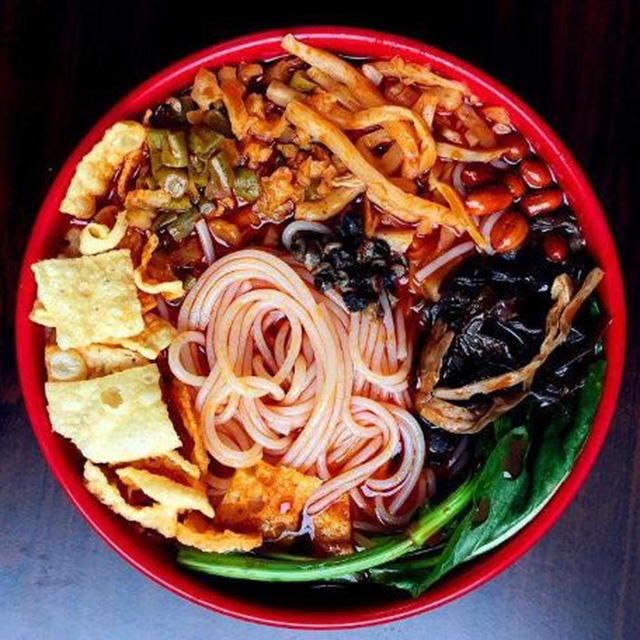
Instant Noodles and China
“Instant noodle” generally refers to cup noodle or packaged dried noodle bricks that come with a variety of flavoring agents and oils, some even with dried bits of vegetables. Instant noodle was first invented by a Japanese entrepreneur called Momofuku Ando in 1958, and ever since, it has spread to many countries, but more than 80% of it is still consumed in Asia. Nowadays, China has the largest consumer market for instant noodle, while Korea ranks first in per capita consumption.[1] As East Asia does not have its own fast-food chains à la McDonald’s and KFC, fast-food culture there takes on a different form, and instant noodle has a particularly sizable following.
In Japanese, instant noodle is known as chikin raamen (即席ラーメン) or insutanto raamen (インスタントラーメン). The former also indicates the quick preparation that the noodle requires, while the latter — along with the Korean term inseuteonteu ramyeon (인스턴트라면) — is a transliteration of “instant ramen.” The nomenclature becomes a bit complicated in the Chinese-speaking world: in Hong Kong, instant noodle is either known as jishi mian (即食麵) — which is akin to the Japanese term chikin ramen — or gongzai mian (公仔麵), which can be traced back to a specific popular brand. In Taiwan, right from the get-go, instant noodle has gone by the name fangbian mian (方便麵), which literally means “convenient noodle.” This name followed a Taiwanese food corporation into mainland China — in the 1990s, Master Kong (Kang Shifu 康師傅) established its first instant noodle factory in Tianjin, and fangbian mian quickly became the prevalent way to refer to instant noodle. Later, another name — paomian (泡面) — emerged, which describes the way that most instant noodle is prepared — i.e., through soaking in hot water.
Master Kong, though not China’s first manufacturer of instant noodle, was certainly the most successful of the 1990s. Soon after, however, the mainland Chinese instant noodle market share came to be split between Master Kong and another dominant manufacturer called Uni-President, which was also a Taiwanese start-up.[2] In 2001, the sales of instant noodle in China was 20 billion packets, but by 2003, the figure had skyrocketed to double that amount. The growth then continued but with a slower rate, until the figure peaked at 46.2 billion in 2013. Sales then went into a three-year decline, dipping to 38.52 billion in 2016.
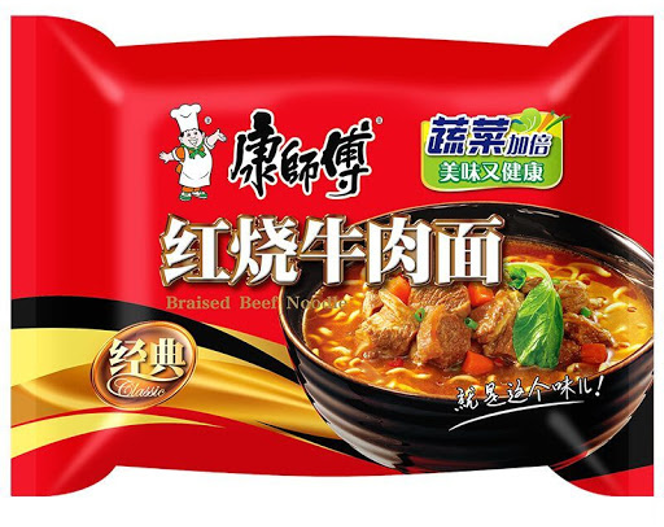
Throughout the 1990s and early 2000s, instant noodle in China was mainly consumed by the young people, college students, and white-collar workers. These groups either did not have access to a decent kitchen or would be too busy to cook on workdays. Instant noodle is often complemented by luncheon meat, the combination of which can be a rather convenient and flavorful way to satiate one’s hunger. Instant noodle is good for any time of the day — for breakfast, lunch, dinner, even as a late-night snack. Back in the 1990s when China’s economy had just started to grow rapidly, the Chinese people did not have as many fast-food restaurant or delivery options as they do today. In the mind of the average Chinese person, instant noodle was the go-to choice when they had grown tired of the food offered in a work unit or college canteen. As a case in point: in his book Shiyu (食遇, “Food encounters”), a Chinese professor He Xiaoyi (何曉毅) describes the time when he first encountered instant noodle during his college days in Beijing, recalling being very impressed by how it even tasted “much better than the handmade noodles offered in the college canteen.” Instant noodle became a staple for him for many years during his time in both Beijing and later in Japan, until he finally grew tired of it.[3]
Changing Landscape of Instant Noodle Consumption
Things began to change in the first decade of the 21st century. A discourse on instant noodle being unhealthy gradually had a noticeable impact on the Chinese people’s choices. Many handbooks on everyday food and nutrition published during this period suggested that people should limit their intake of instant noodle. With the spread of nutritional knowledge among society, people became aware of the lack of proteins, vitamins, and minerals — all of which daily dietary essentials — in instant noodle.
Moreover, with increased food options including from street vendors, small eateries, and fast-food chains, instant noodle became less appetizing to the Chinese people. Some started to ridicule a disclaimer printed on Master Kong’s packaging that claimed, “The image shown here is for indication only. Actual product may differ.” On the packaging of their flagship braised beef–flavored noodle is a picture showing large pieces of beef perched atop a bed of noodle — needless to say, when one breaks open the package, not an ounce of beef will be found.
To prepare instant noodle, one supposedly soaks it in hot water for two to five minutes before serving — such is the crux of their “instantaneity.” Over time, however, Chinese people have developed a habit of cooking the noodle in boiling water to render a better taste. Some add on vegetables, poached eggs, and/or luncheon meat to assemble a somewhat more nutritionally-balanced meal. This evolved way of preparing instant noodle is not unique to mainland China; in Hong Kong, one easily finds similar dishes on local restaurants’ breakfast menus. In popular Korean cuisine, budae-jjigae (부대찌개, army base stew), instant noodle is also an essential offering.[4]
This is where instant noodle meets cooking. As instant noodle has gained notoriety for their being unhealthy and monotonous, more and more recipes in recipe books and on the Internet start to teach people how to make instant noodles in healthier, and more importantly, more delicious ways. One readily finds a plethora of ideas on how to switch up a packet of instant noodle: adding a fried egg, stir-frying it, serving it in a tomato soup, adding vegetable condiments, topping it with cheese are just a few quick examples.
By early 21st century, the instant noodle market had become saturated, and manufacturers had to re-strategize to break out of the sluggish growth cycle. A common way was to bake instead of fry the noodle into bricks, thereby reducing the amount of fats in the product. Nonetheless, this soon proved to be unsuccessful, since baking noodles could not recreate the same zing found in fried foods. Also, if a consumer chooses to eat instant noodle for a meal, health would not be the first concern. After all, it is instant noodle — how healthy can it be?
Efforts to make instant noodle healthier and more wholesome thus appeared to have hit a dead end, and manufacturers seemed to head toward another direction to increase profit. In 2009, Uni-President released a new flagship product: pickled cabbage and beef-flavored noodle (laotan suancai niurou mian 老坛酸菜牛肉面). Inspired by Sichuanese cuisine, this product combined the sourness of pickled cabbage with spicy flavors, and it soon found commercial success. Sales reached 500 million RMB in 2009 and doubled in the next year. The product was so popular that it forced its competitor Master Kong to release a product with a similar taste and name, causing Uni-president to openly accuse Master Kong of stealing their idea.
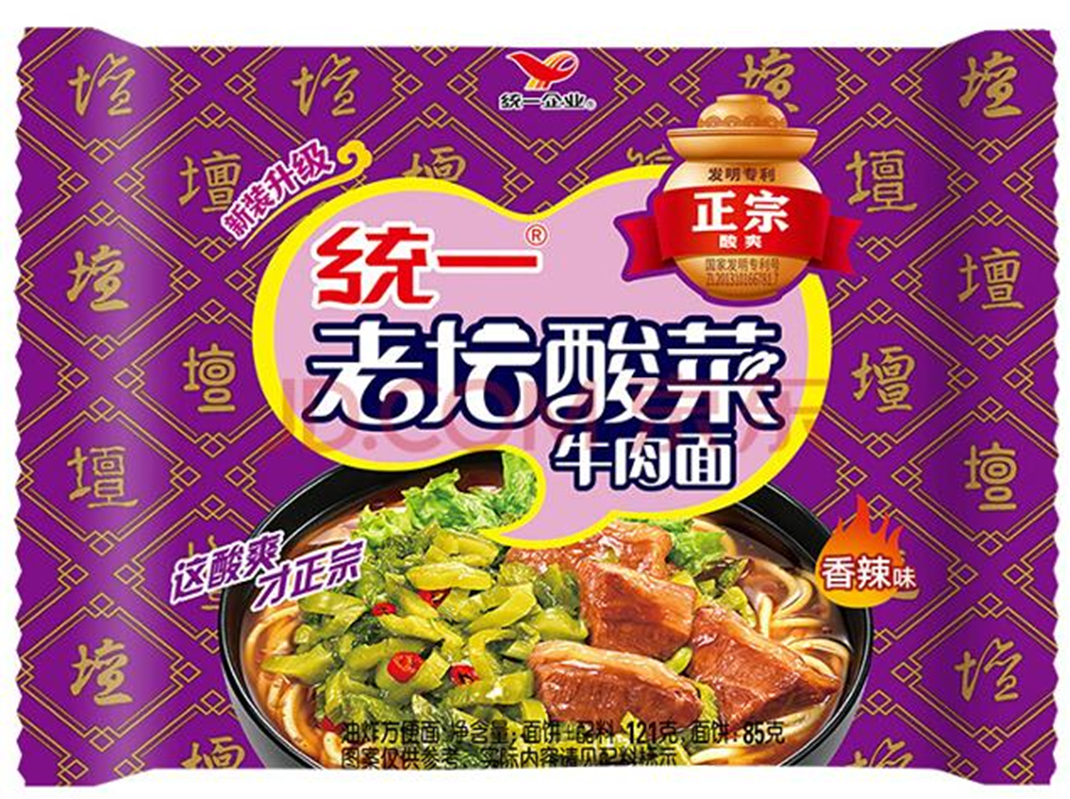
The landscape of instant noodle consumption continued to change in the 2010s in China. More and more new flavors appeared on supermarket shelves. The development of social media also produced several instant noodle “superstars,” most of which were imported products. The most representative were the Korean buldak-bokkeum-myeon (hot chicken–flavored ramen) and shin ramyun (spicy ramen). The former was known for its extra spiciness; the latter for its flavor of Korean spicy sauce. Both were popular among young people. In fact, instant noodle continues to be popular with young people in China, especially college students and white-collar workers, who tend to be adventurous with new, exotic, even unusual flavors, and, among all recent instant noodle superstars in China, one particular stands out — luosi fen.
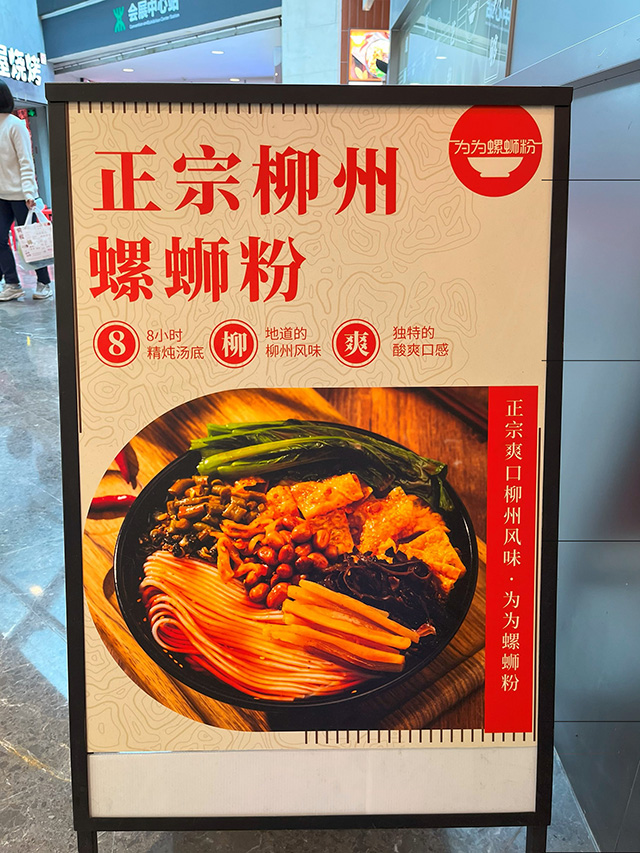
The Rise of Luosi Fen
In the fall of 2019, season two of the popular documentary “Breakfast in China” was released on the Internet. The show aggregated 240 million views after one year of formal release. One of its episodes revolved around a luosi fen vendor in Liuzhou (柳州) in Guangxi province. The episode opened with the question “Are there really snails in luosi fen?”[5] This was not the first time that luosi fen had garnered national attention. As early as 2012, a well-known documentary on CCTV called “A Bite of China” sparked national enthusiasm on authentic regional local delicacies, and the first episode of season one dedicated two minutes to introducing Liuzhou’s fermented bamboo sprouts, a notable ingredient of luosi fen. Luosi fen thus shared ten seconds of spotlight.
In addition to fermented bamboo sprouts, luosi fen combines other elements of Liuzhou including rice noodle, river snails, pickled beans and radish, black fungus, fried beancurd sticks, peanut, and, last but not least, chili oil. The river snails — the “luosi,” or bellamya quadrata — are found in many parts of south China and have been incorporated into the local cuisines of Zhejiang and Guangxi among others. The snails provided an alternative source of protein when both fresh meat and processed meat products were in short supply in China before the reform era. However, a bowl of luosi fen does not contain any snail meat. In fact, it is an open secret that the snails are only used to cook the soup, and — after being simmered in the soup for hours along with pork bones and a great deal of spices — they are part of the reason why the soup is so flavorful. Today, as much as luosi fen is a collective term for what seems like a singular item of local delicacy, because individual vendors’ recipes differ from each other, their offerings can be quite diverse and vibrant.
The exact origin of luosi fen may be difficult to pinpoint — it most likely dates back to the late 1970s. In the 1990s, several tourist guidebooks began to feature luosi fen. A local food company was also established to make an instant version of it.[6] Nevertheless, the luosi fen back then was not quite the same as the versions that we find today In its description back then — “sour, spicy, savory, refreshing, and burning” — there was no mention of its stinkiness. In fact, that luosi fen is stinky did not become a highlight until 2015.
2015 turned out to be a significant milestone for luosi fen — in addition to adopting stinkiness, it was transformed from a street food into an industrially-produced instant noodle product, and promoted from a local delicacy into a nationally recognized food, as well as becoming much closer to achieving commercial success. Most manufacturers of the popular brands of instant luosi fen seen today were all registered in 2015 and after. In that same year, the local government of Liuzhou also gave luosi fen an official English name — “Liuzhou river snails rice noodle.”
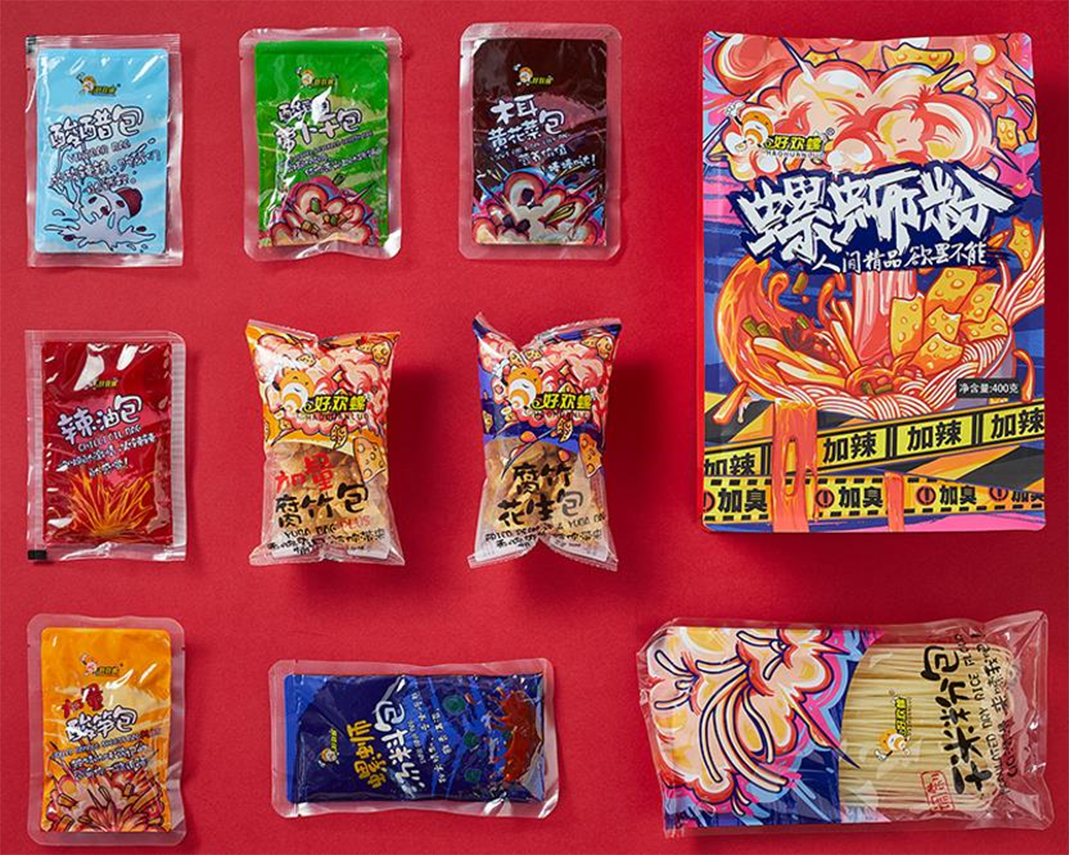
Preparing Luosi Fen at Home
Inside each package of instant luosi fen are several small packets — a packet of the dried rice noodle, a packet of snail soup mix, and individual packets of chili oil, fermented bamboo sprouts, pickled beans, radish, black fungi, fried beancurd sticks, peanut, and in some cases, vinegar. This is all a bit similar to other instant noodles at first sight, except that there are more packets here. The reason that instant luosi fen has such elaborate content is because it is meant to be fully cooked, not soaked, and one should follow the cooking instructions on the packaging. Certainly, normal instant noodles have instructions on their packaging too, but luosi fen’s preparation is more complicated. One brand of luosi fen even has the small packets numbered according to the sequence that they are supposed to be utilized.
A typical procedure for preparing packaged luosi fen is as follows: first, the rice noodle needs to be pre-soaked for half an hour in cold water, before being boiled for five to eight minutes (15 minutes if the noodle has not been pre-soaked). To make the noodle more al dente, several drops of vinegar may be added as the noodle is being boiled; the noodle is then removed from the boiling water and plunged into cold water. The noodle is brought to a simmer once more as the other packets are added. If preferred, extra toppings such as lettuce and parboiled/fried egg can also be added.
Though the procedural details may differ from product to product, packaged luosi fen is generally prepared like this and takes 20 to 30 minutes from start to finish (excluding pre-soaking the noodle), which hardly suggests instantaneity (in fact, most people in China would not classify luosi fen as fangbian mian). Nevertheless, a truly authentic bowl of luosi fen otherwise requires a great deal more time to prepare from scratch; the soup alone would take half a day to make, not to mention the fermented bamboo sprouts and pickles which generally take weeks and months to prepare, so the packaged version of luosi fen can, indeed, be considered “fast” if not fully “instant.”
A quick browse online for luosi fen products will show that they are always listed under “fangbian shipin” (方便食品, which translates into “convenience food”). Terminology in the Chinese language in fact plays a part in shaping the Chinese people’s perception on what constitutes “instant” food: the term “fangbian” itself does not directly translate into “instantaneity” or even just “speed,” only “convenience,” but this notion of “convenience food” — food that is convenient — can be broadly and ambiguously suggestive: a food product can be convenient because it is easy to prepare and cook; it can be convenient because the package already contains everything required to make a complete, wholesome meal — there is no need to scavenge for any addition ingredients; it can also, indeed, be because the food takes only a short time to ready. This last association has induced a new term for convenience foods — supeng liaoli (速烹料理, fast-cooking food); however, people have not taken it too well.
Today, China’s urban middle class no longer cook as (often as) their parents used to; many of them have developed a new attitude toward cooking. For them, cooking is no longer considered family labor but a form of entertainment and family bonding. A young couple working in a big city may prepare a meal together from scratch on the weekend. But during weeknights, any easy-to-prepare food will be perfect after a day of hard work. Having to appeal to this clientele, the manufacturers of luosi fen themselves are reluctant to categorize their products as “instant” or “fast” food, not only because of the recognition that the products take more than an instant to be ready, but also because of negative connotations that are associated with having the label of “fast” or “instant” food. So, instead of highlighting speed, they have found a winning marketing recipe — to tout luosi fen as an authentic rendition of a local, down-to-earth delicacy.
“Extra Stinky, Extra Spicy”: Triumphant of a Proletariat Culture
This marketing strategy proved successful very quickly; luosi fen soon became a bestseller on China’s online shopping platforms. Since, however, the marketing might have gone too far into seemingly counterintuitive territory: a quick search for “luosi fen” on Taobao, China’s largest online shopping platform, and a hard-to-miss banner promoting “jia chou jia la” (加臭加辣, which translates into “extra stinky, extra spicy”) will appear at the top. This notion of associating stinkiness with good good may sound paradoxical, but there has been no shortage of precedents involving stinky foods that are delicious and popular. Fermented tofu, which is an even more popular Chinese delicacy, comes to mind. Japan’s natto (納豆, fermented soybean) is another example. In fact, fermentation has had a long history in East Asian food cultures. It gives a food item more complexity in flavor as well as preserves the food, making it possible and easier to keep for a long period of time. This, however, does not discount the fact that fermentation does in some cases produce volatile chemicals that smell fusty (e.g., Surströmming, Swedish fermented herring) and repulsive to some people.
Fortunately, for luosi fen, its stinkiness has not made it repulsive, but topical on social media, and, often, a great way to market a product is just to get people to talk about it and to pique more people’s curiosity. Since 2016, many vloggers, influencers, and online personalities have shared lifestyle content on social media, and videos about food and cooking always draw many followers. Videos that feature luosi fen may feature their hosts with a bowl of luosi fen, frowning, grimacing, covering their noses at first, but upon getting past that reluctant first taste, being completing won over by all the amazing flavors. These videos may be dramatized for extra effect, but are informative nonetheless — some hosts review and rate entire lines of luosi fen products; others dispel the common misconception that luosi fen’s stinkiness comes from the snail in its soup, and explain that it in fact comes from the fermented bamboo sprouts. Such phenomenon of “Internet celebrity economy” has greatly influenced and altered marketing and retailing strategies in China.[7]
If its stinkiness was what drew people to try luosi fen in the first place, then its “spiciness” might have been the reason for its popularity. Chili pepper has long been incorporated into many local cuisines in China especially in the southwest provinces such as Sichuan, Guizhou, Yunnan, and Guangxi, since its first introduction in the late 16th century. However, it was not until the recent two decades that spicy food began to gain nationwide popularity, mostly through the spread of Sichuanese cuisine across the country. Unlike other regional cuisines in China which mostly establish fancy, gentrified restaurants in other parts of the country catering to high-end markets, Sichuanese cuisine has taken on a more proletariat (i.e., being authentic and affordable) form to attain high popularity.[8] This cuisine, which was formed among migrants and lower-class workers roughly a century ago, combines and refashions commonplace, cheap (sometimes even somewhat stale), but robust ingredients — chili oil, Sichuanese pepper, pickled vegetables, fermented bean paste — into appetizing foods.
Luosi fen is not itself Sichuanese, but it shares Sichuanese cuisine’s marriage of chili peppers with Sichuanese pepper, which gives a tingling feeling on the tongue, adding another layer of complexity to the flavor, and balance of spiciness with sourness coming from the pickled or fermented vegetables (especially fermented bamboo sprouts) which renders an even zestier taste. In addition, luosi fen shares Sichuanese cuisine’s spirit of having a humble, street-food heritage — its original intention was to provide common workers with a cheap but satisfying and filling meal. But since that 2012 episode of “A Bite of China” that featured luosi fen, numerous other food programs have chimed in to disseminate a new attitude toward regional, local foods: the most delicious and authentic local cuisines are not found in fancy, touristy restaurants; they are offered from ordinary, down-to-earth households and street vendors.
As much as luosi fen is a bowl of proletariat ingredients, the “Internet celebrity economy” phenomenon is also a proletariat form of marketing: vloggers are but common folks who share their lifestyle and everyday stories, and their followers trust them more than celebrities of the classical sense. However, luosi fen’s triumph of proletarianism does not mean that it only targets low-end consumers. They cater to the urban middle class all the same. In fact, China’s contemporary urban middle class are in more ways than proletariat in the metropolises: they retain some self-deprecating tendencies to mock their own modest roots, but they are also gradually coming to pay more attention to quality and the finer things in life, especially regarding the food they eat. At the same time, they continue to be price-conscious, as there are other financial burdens such as housing, healthcare, and their children’s education.
This is also why numerous small, tidy restaurants of regional cuisines have found their way into CBDs and upscale urban shopping malls. They provide white-collar workers with quick, satiating meals at a reasonable price during the workdays. Meanwhile, the instant versions of luosi fen and similar products have taken over a large share of the instant noodle market.
People who consume instant noodle in the 1990s and those who consume luosi fen today also share similar social statuses. In fact, luosi fen can be considered a high-end form of instant noodle — as much as it is not as “instant” as traditional instant noodles, what it lacks it makes up for by offering more complex, exciting flavors, while bringing more fun and ease to the cooking process.
A New Taste of Home: An Emerging Consumer Culture of Instant Noodle in China
Luosi fen is not the only local delicacy that has experienced the “instant-ization” treatment. Another successful example is Baman (brand)’s Hunan-style rice noodle. Baman was founded in 2014 by a master’s graduate of Peking University who started his first restaurant in Beijing selling a rice noodle of his hometown, Changde in Hunan province. His initial plan was to develop his own restaurant chain, but he found bigger success selling the instant version of the rice noodle (launched in 2016) online. More importantly, his success story has become an archetype of a talented young man endeavoring to identify and fill a niche in the market, and has inspired multiple other local food chains to “instant-ize” their flagship products. Now, one can find numerous regional instant noodles on online shopping channels.
The year 2016 also saw another successful Chinese brand of instant ramen, Ramen Talk, emerge. Ramen Talk’s popularity matched luosi fen’s during the COVID-19 pandemic. On Ramen Talk’s official website, it claims that the goal of the company is to allow consumers to “cook Japanese ramen at home.” Their target consumers are “young people who are busy at work but still pursue a high-quality lifestyle.”[9] However, even though Ramen Talk promotes their products as “authentically” Japanese, their bestsellers are those that come with flavors and toppings adapted from Sichuanese and Southeast Asian cuisines, both of which known for their spiciness.
Indeed, all these new brands of instant noodle aim to market their products as new, healthier, and more delicious substitutes for traditional instant noodles. Now, the noodles are no longer fried, but are often offered dried or even raw. Developments in food processing and preservation technologies have also made it possible to packet (more) actual meat and pickles into the products. Instant noodles are now designed to be cooked, albeit through some simple, convenient processes. More importantly, they not only offer consumers access to delicious, “authentic” local foods at home, unlike traditional instant noodle, they also make it possible to achieve results that are as amazing as those shown in promotional pictures, if prepared with care. The fact that, around 2016, instant noodle products highlighting local flavors were a booming business was no coincidence, and online videos as well as the “Internet celebrity economy” phenomenon played no small parts in it. To begin with, instant noodle has always had an underlying element of localness, which previous marketing strategies sometimes neglected. For example, Master Kong’s flagship product, braise beef–flavored noodle, came from a popular and signature Taiwanese delicacy — any Taiwanese restaurants would have it on their menus; Uni-President’s “pickled cabbage and beef flavored noodles” also demonstrates the power of highlighting local flavors as part of a marketing strategy. What the advent of online videos has contributed to this success is to allow ordinary people to browse diverse local street foods through simply tapping on a screen, thereby creating a large potential consumer base for these local delicacies. Moreover, with online shopping platforms, the giant online retailers in China can expand sales into third-tiered cities, small towns, even the villages. “high-end,” “instant” noodle manufacturers have been able to capitalize on all these aspects and create diverse, flavorful, accessible, and affordable products that cater to a broad spectrum of the populace, from the urban middle class to the local proletariat. Now people in every corner of China can afford to cook delicious, “authentic” regional foods in their own kitchens.
Footnotes
- See the website of World Instant Noodles Association, https://instantnoodles.org/en/noodles/report.html.
- In Master Kong’s Chinese name “kang shifu” (康師傅), “kang” conveys the idea of “healthfulness,” while “shifu” is an honorific used to address artisans (including chefs). The Chinese name for Uni-President “tongyi” (統一), which means “unification”, has political implications.
- He Xiaoyi 何曉毅, Shiyu 食遇 [Food encounters] (Shanghai: Shanghai sanlian shudian, 2015), 15–18.
- For a brief history on Budae-jjigae, see https://contexts.org/articles/eatingmilitary-base-stew/.
- The documentary may be accessed at https://v.qq.com/x/cover/mzc00200z537hbl/b0032gxfg2p.html
- Qiu Hongxun 邱鴻勛 et al., Zhongguo shipin gongye niannian 1993–1996 中國食品工業年鑒 1993–1996 [Yearbook of food industry in China, 1993–1996] (Beijing: China Light Industry Press, 1997), 619–620.
- For more on Internet celebrity economy, see https://targetchina.com.au/article/internet-celebrity/.
- Cao Yu 曹雨, Zhongguo shi la shi 中國食辣史 [A history of chili pepper consumption in China] (Beijing: Beijing Union Press, 2019). Also see an article entitled “Sichuan Cuisine, Imperiled by Success” in The New York Times, https://www.nytimes.com/2016/06/15/dining/chinese-food-sichuan-chengdu.html.
